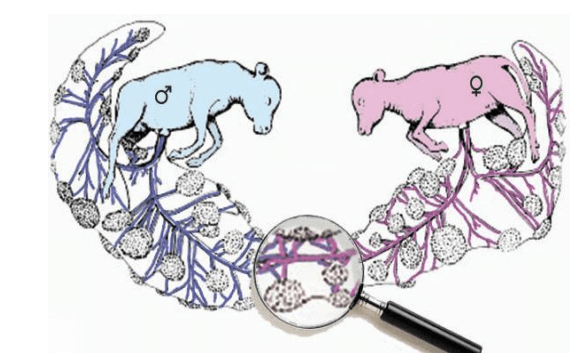
Twin births in cows are a source of great joy for farmers. With the occurrence of twin births, the increase in animal population on a farm becomes faster. However, it's not uncommon for abnormalities to occur in twin births, known as freemartin or freemartinism. By understanding what freemartin is, we can take initial steps to minimize the resulting effects.
Freemartinism is a specific form of intersexuality in cattle and is the most commonly found form of intersexuality. This type of pathology can also be observed in buffaloes and small ruminants, although in goats and sheep, other forms of intersexuality are more common than the freemartin syndrome.
The freemartin phenotype is seen in dizygotic twin pregnancies where one offspring is male and its twin is female. Due to the premature connection (precocious anastomoses) of the placental vascular system of the two fetuses, masculinizing molecules reach the female fetus and disrupt normal sexual differentiation. In male fetuses, the effect of this anastomosis is usually minimal. In cows, this condition occurs in about 90 to 97% of twin pregnancies where one is male and the other is female.
As a result of placental anastomosis between heterozygous twin fetuses, chimeric blood occurs (an individual has more than one blood phenotype). Additionally, hormone and gonad-determining factor (such as anti-Mullerian hormone and androgens) crossover takes place, disrupting the gonad differentiation of the female embryo and interfering with the development of the genital tract. Compared to the dramatic changes that occur in freemartin females, male twins only show minimal defects, although a decrease in fertility has also been reported.
A freemartin individual is a female fetus masculinized due to the presence of its male twin, resulting in the female being born sterile. Varying degrees of genital tract defects are found in freemartin animals. The most common defect is the suppression and disorganization of the ovarian organs, which become rudimentary testis-like structures derived from germinal cells. The uterine horns may be hypoplastic (undersized) or even abnormal, resembling a heart-like structure and hanging from a wide ligament. Disconnection between the uterus and vagina is often found, rendering the two organs separate, and rudimentary vesicular glands (loss of function and atrophy) may also be present. External genitalia abnormalities include an enlarged clitoris, a reduced vulva, and protruding hair similar to that of males.
The external genital organs of freemartin females usually appear feminine, but slight differences can be identified upon closer examination. These animals typically grow up as females. However, internal female reproductive organs may undergo varying degrees of masculinization, disrupting the individual's reproduction and fertility. Common defects include the absence of anatomical connection between the vagina and uterus, small or absent uterine size, hypoplastic gonads, and the presence of vesicular glands.
In cows, the trend of twin births is related to genetic backgrounds associated with hormonal regulation that results in multiple ovulations in the dam. However, various studies suggest that genetic determinants in the formation of twin pregnancies seem to have a smaller influence compared to factors related to management and the environment, especially in dairy cows. In high-producing dairy cows, it has long been mentioned that the increased occurrence of twin births is a consequence of hormonal disturbances and metabolic imbalances in energy equilibrium immediately after calving. An increase in twin birth incidence in cows is often followed by a slight increase in freemartin occurrences on a farm.

Anastomosis (connection) between two different-sex cattle fetuses (based on literature)
Source:
“Ruminants Anatomy, Behavior and Diseases”. 2012. Evandro Mendes. Nova Science Publisher, Inc. New York.



